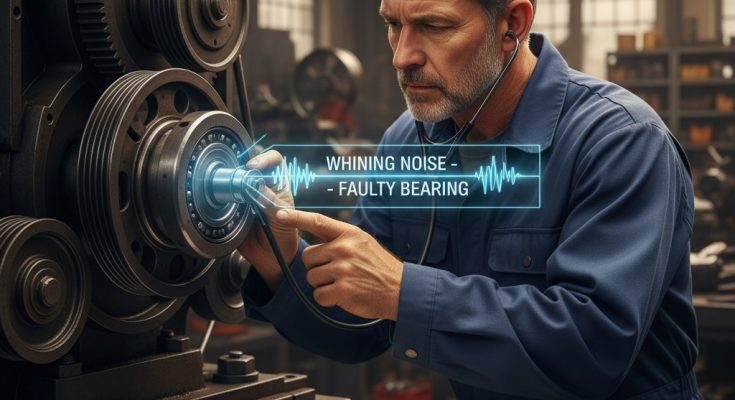The Soundtrack of Trouble: How to Diagnose Faults by Abnormal Noise
Every machine has a symphony it plays when it’s running well – a hum, a whir, a steady thrum. But what happens when the music changes? When that familiar rhythm is replaced by a screech, a clunk, or a groan? That, my friends, is the sound of trouble brewing, and learning to interpret these abnormal noises is a powerful diagnostic tool.
Ignoring unusual sounds is like ignoring a smoke alarm; it might not be a raging fire yet, but it’s a clear warning. By paying attention to the “soundtrack of trouble,” you can often identify and address faults before they lead to catastrophic failure, saving you time, money, and a whole lot of headaches.
So, how do you become a master of machine acoustics?
Step 1: Know Your Normal
Before you can identify what’s abnormal, you need to be intimately familiar with what’s normal. Spend time listening to your machinery when it’s operating correctly. Record the sounds if you can, or simply pay close attention to the various hums, clicks, and whirs. This baseline understanding is crucial.
Step 2: Characterize the Noise
Once you hear something out of the ordinary, don’t just dismiss it. Become a detective and try to characterize the noise as precisely as possible:
-
What kind of sound is it? Is it a squeal, a grind, a thud, a rattle, a hiss, a clang, a whine, a knock, a buzz?
-
What is its pitch? High, low, fluctuating?
-
What is its intensity? Loud, faint, intermittent?
-
When does it occur? Only at startup, under load, at a specific RPM, during a particular movement, continuously?
-
Where does it seem to be coming from? Pinpoint the location as accurately as possible. Use a mechanic’s stethoscope or even a long screwdriver pressed to different parts of the machine to help isolate the sound.
Step 3: Common Noises and Their Potential Meanings
Here’s a quick guide to some common abnormal noises and what they often indicate:
-
Squealing: Often points to friction. Think loose or worn belts, dry bearings, or brake issues.
-
Grinding: This is a serious one, suggesting metal-on-metal contact. It could be worn gears, failing bearings, or something scraping where it shouldn’t.
-
Thudding/Knocking: Usually indicates something is loose or out of balance. This could be a loose component, an imbalanced fan, or even an engine issue like a rod knock.
-
Rattling: Loose fasteners, worn linkages, or components vibrating against each other are common culprits.
-
Hissing/Whooshing: Frequently points to air or fluid leaks in pneumatic or hydraulic systems, or vacuum leaks in engines.
-
Clanking/Clunking: Suggests excessive play or impact between parts. Worn universal joints, loose suspension components, or worn gears can make these sounds.
-
Whining: Often associated with high-speed rotating components. Could be a worn bearing, a failing pump, or a differential issue.
-
Buzzing: Electrical issues are a common cause, such as loose wiring, failing relays, or vibrating solenoids.
Step 4: Investigate and Correlate
Once you’ve characterized the noise, it’s time to investigate. Start by inspecting the areas you suspect based on the sound. Look for:
-
Visual cues: Leaks, worn parts, loose fasteners, discoloration, excessive vibration.
-
Touch cues: Excessive heat (bearings, brakes), abnormal vibration.
-
Smell cues: Burning oil, burning rubber, electrical burning.
Correlate the noise with any changes in performance. Does the machine lose power when it makes the sound? Does it become less efficient?
Example in Action: The Whining Bearing
Imagine a continuous, high-pitched whine emanating from a rotating shaft on a piece of industrial machinery.
-
Noise Type: Whine
-
Location: Appears to be coming from the bearing housing on the shaft.
-
When: Continuous when the machine is running.
Investigation might involve:
-
Feeling the bearing housing: Is it unusually hot?
-
Using a stethoscope: Pinpointing the exact source of the whine to the bearing itself.
-
Visual inspection: Are there any signs of lubricant leakage or rust around the bearing?
Conclusion: A high-pitched whine often indicates a failing bearing, especially if accompanied by heat. Replacing the bearing proactively can prevent a shaft seizure and much more extensive damage.
The Takeaway
Developing your ear for machine noises is an invaluable skill for anyone working with mechanical or electrical systems. It takes practice, patience, and a keen sense of observation. By actively listening, characterizing, and investigating abnormal sounds, you can transform from someone who just hears noise into a true diagnostician, capable of identifying and resolving faults long before they become critical.
So, next time your machine starts singing a different tune, don’t just turn a deaf ear. Listen closely – it might be telling you exactly what’s wrong.



